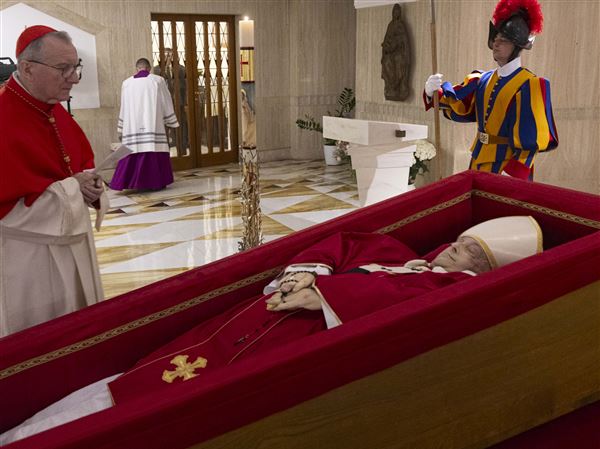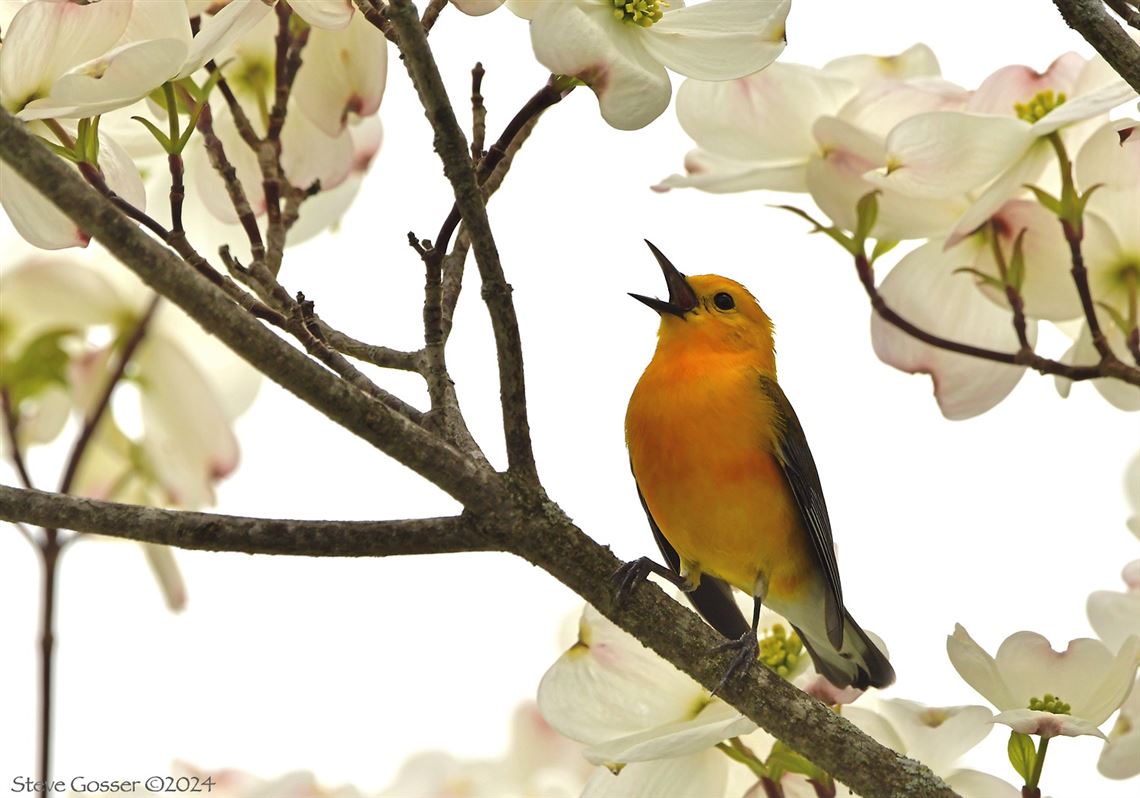With a nerdy reputation, birders might not seem to be the competitive or athletic type. But they are for the World Series of Birding in Cape May, N.J.
In its 41st year, the event features upwards of 100 teams scouring Cape May County and the state vying to count the most bird species in 24 hours. The event raises awareness and funds to help protect birds.
Although it’s not quite like the Jack Black, Steve Martin and Owen Wilson movie, “The Big Year.” It’s the same concept, just centered in one area on one day.
Three teams from Saint Vincent College in Latrobe participated this year on May 11.
“You are just running on caffeine and snack food,” said James Kellam, an ornithologist and an associate professor of biology and environmental science at Saint Vincent’s Herbert W. Boyer School of Natural Sciences, Mathematics and Computing.
Kellam has been leading students at the World Series since 2017. They take his one-credit course, a birding boot camp, to learn how to identify 175 bird species to compete in the series in spring.
When most people think of Cape May, busy beaches and stately Victorian homes come to mind. But off-season, the resident and migratory bird habitat is so diverse and rich that Cape May is usually ranked as one of the top 10 birding spots in the country.
Let’s count
Cassy Lanza, 20, of Harrisburg, who will be a junior this fall at Saint Vincent, relied on her cross-country and track training at the college for stamina on the big count day.
This year was her second time enrolling in Kellam’s class and competing in New Jersey.
“Endurance and optimism was a big part of it. Our mindset of sticking it out helped – 24 hours is a long time,” she said.
Before taking Kellam’s class, Lanza had only a mild interest in birds. But she wanted something educational and fun to share with several running friends at Saint Vincent.
They dubbed their birding team the Bearcat Harriers.
Kellam started taking students to Cape May after a 1972 Saint Vincent alumni, Jim Wilson, invited them.
Wilson, 74, a native of West Mifflin and a current resident of Queenstown, Md., is retired from the National Security Agency, where he was a mathematician and an international relations expert.
He has competed in about 27 world series and came in second place this year in his division with a team made up of mothers of former birding students.
‘Heck of a lot of fun’
Over the years, Wilson said he grew tired of the Cornell Lab of Ornithology’s team with students, the Redheads, always winning. He wanted to include students from his alma mater.
Wilson had already taught and trained for the world series with grade school and other students in Queen Anne County Public Schools in Maryland.
“I could see what the young kids can do and learn and never doubted that,” he said.
Wilson tells his birding students that the World Series is the hardest test they will ever take and “it’s just a heck of a lot of fun.”
Camaraderie and integrity are the main ingredients, no matter the age of the competitors.
“There are no bird police. No one is looking over your shoulder saying, ‘You did not see that bird. You are wrong.’”
Wilson perused Saint Vincent’s website and discovered the college had an ornithologist on staff, Kellam. He cold-called him and asked if he wanted to compete and bring some students to New Jersey.
Wilson helped support the college’s first effort by assisting with room and board and helping Kellam teach birding techniques he developed.
“Jim Kellam got hooked,” he said.
For the first year in 2017, Wilson flew into town to meet the three participating students and Kellam at DeNunzio's restaurant in Latrobe. He brought gift bags, T-shirts and bug repellant.
Wilson continues to support the Saint Vincent birding class. The college’s biological sciences Department, a private donor and a Saint Vincent alumnus fund the school’s teams for the World Series of Birding.
“Jim is getting close every year to the Cornell Redheads,” Wilson noted. “Hopefully they will catch up to them and beat them.”
Driving around
Driving around and exploring places looking for new birds was the best part of the World Series, Lanza said.
“I treated it like a big scavenger hunt.”
Luck plays a major role.
“Sometimes the birds are just not there and sometimes they are,” she said.
Lanza enjoyed the variety of birds in different habitats from the ocean to the deep forest.
“It’s exhilarating to hit every possible habitat that we don’t see at Saint Vincent,” she added.
Cape May’s diverse natural areas, where nary a beachgoer is found, accounts for its magic, Kellam said. There’s the bay, ocean, shore, forest, woodlands, saltwater marshes, freshwater wetlands and urban areas.
Since different birds frequent each habitat, watchers can rack up species visiting multiple spots.
The Latrobe team arrived two days early to scout the best birding locations.
On the count day, the teams set out at midnight to listen for owls. Then they got into position at 4 a.m. in the forest to listen to the dawn chorus to identify by song multiple bird species.
“The most intense time is the first minutes right at sunrise or just before,” Kellam said.
Yes, birders can identify species by their songs alone. However, they can’t use Cornell’s Merlin app to identify vocalizations while in the field on count day.
The honor system
The honor system for reporting birds still applies in organized birding competitions.
A Cornell Lab of Ornithology review of “The Big Year” noted truisms of the Hollywood treatment of the hobby: “Whenever people first hear of competitive birding, the hardest thing for them to believe is the honor system. But it works.”
In Kellam’s course, students learn to identify about a dozen species a week through memorization with some fieldwork.
By the time they compete in the World Series, the students have learned to identify about 175 species.
For the big day, after investigating forest-dwelling birds early in the morning, the Saint Vincent students hit the beach to search of shorebirds at low tide. They also visited sites with rookeries to pick up multiple species of herons.
“You’ve got to have a strategy and it has to be flexible,” Kellam said.
If they pick up certain species, they’ll move on to finding new ones.
“Once you have seen your first robin, you have to not look at them,” he said.
They typically tally 100 species by 2 p.m. After that, it’s harder to turn up new birds.
“With every new species you find you get a burst of dopamine and as the afternoon wears on you get fewer bursts of excitement,” Kellam said.
An ironman athlete, he worries more about his students’ endurance than his own. His sports watch totaled 20,000 steps and a 3,700-calorie burn on count day.
It’s a game of endurance fortified by a nap between 2 and 4 p.m.
Their last stop was an old airfield at about 9:45 p.m. They parked and with the windows rolled down, they heard nothing.
“‘Give it five minutes,’” Kellam told the students.
Then they heard the faint call of a chuck-will’s-widow, which is seldom seen but frequently heard at night.
“That was a high-five moment,” he said.
The Saint Vincent birding group tallied 116 species of birds.
The goal isn’t to turn the students into ornithologists. Indeed, many of the students aren’t studying biology, Kellam said.
“I want birding to be more of a lifelong hobby for them so they know more about the world around them and appreciate it.”
Mary Ann Thomas: mthomas@post-gazette.com
First Published: June 12, 2024, 9:30 a.m.
Updated: June 13, 2024, 6:10 p.m.




















